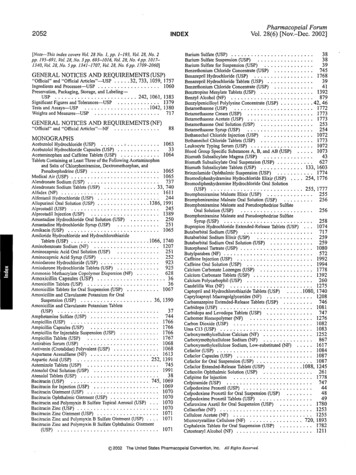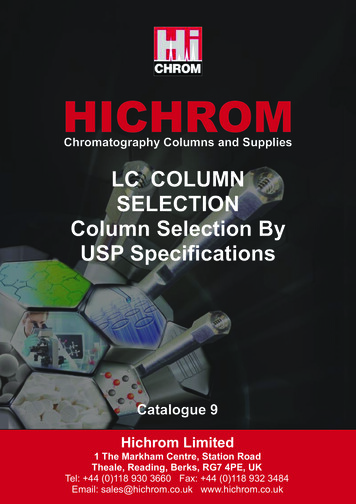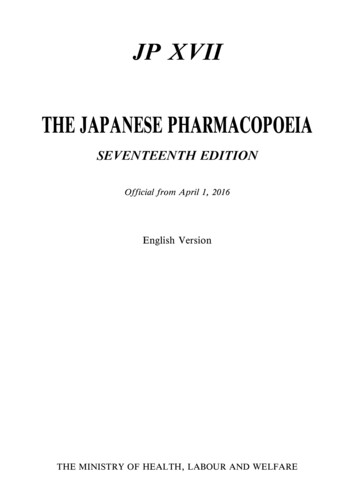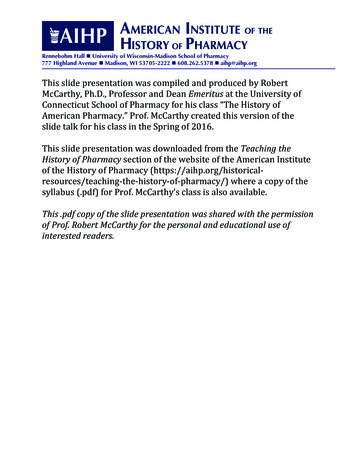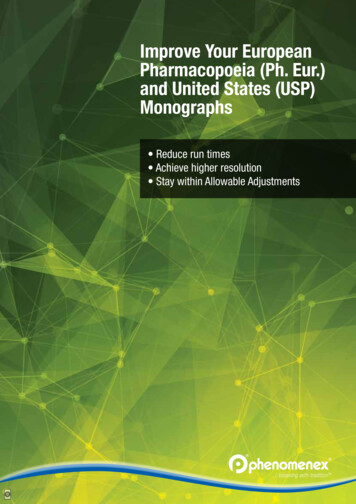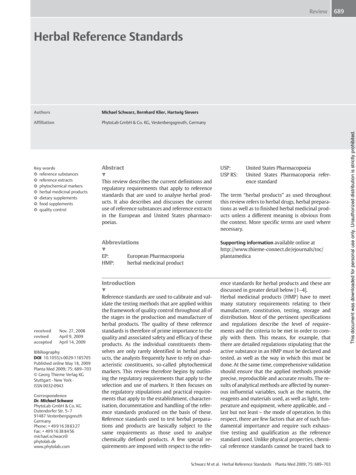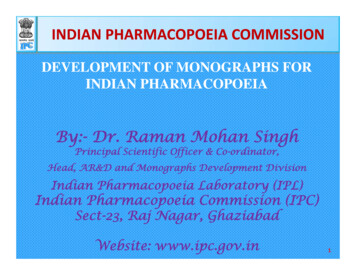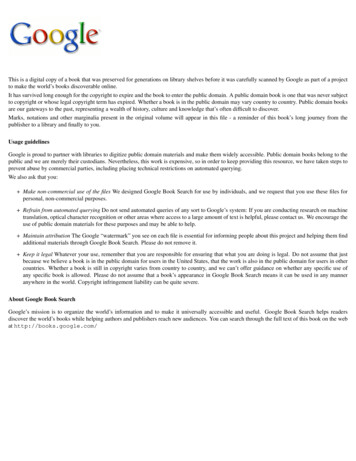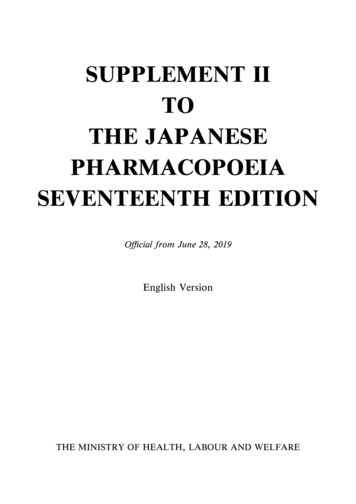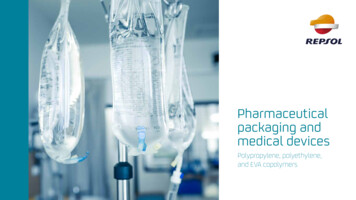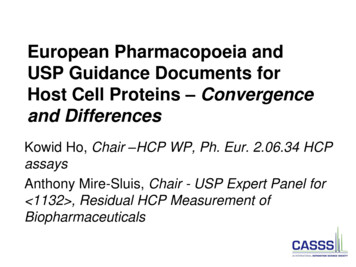
Transcription
European Pharmacopoeia andUSP Guidance Documents forHost Cell Proteins – Convergenceand DifferencesKowid Ho, Chair –HCP WP, Ph. Eur. 2.06.34 HCPassaysAnthony Mire-Sluis, Chair - USP Expert Panel for 1132 , Residual HCP Measurement ofBiopharmaceuticals
37 Member States and the European Union are signatory to theConvention on the Elaboration of a European ap of member and observer countries 2014.jpg
Ph.Eur General Notice Monographs: mandatory requirements unlessotherwise indicated General chapters:– become mandatory when referred to in a monograph,– unless such reference is made in a way that indicatesthat it is not the intention to make the text referred tomandatory but rather to cite it for information.3
4
EP 2.6.34 host-cell protein assaysType of assay Process-specific assays (also called product-specific HCP assays)– Developed and validated taking into account the specificity of the production process andusing the host organism expressing the recombinant product.– Antigen derived from a mock run of the drug substance manufacturing process (or a processrepresentative of it) up to a step capable of generating sufficient quantities and broadspectrum of HCP.– Antisera raised need to have a broad coverage of HCPs, to be able to detect as manydifferent HCPs as possible and thereby also accommodate process variations.Platform assays– developed by individual manufacturers and customised for their expression host andprocesses.– same sets of reference standards and reagents may be used to monitor HCPs in severalproducts manufactured in the same expression host, provided that upstream (anddownstream, if relevant) processes are sufficiently similar between these products.Generic assays– Commercially available HCP test kits are commonly referred to as generic HCP assays.They are intended to work broadly across similar expression hosts. Detailed information onthe preparation of the assay may not be disclosed by the vendor. For instance, the null cellline may be derived from a combination of strains of an expression host species, and theprocess(es) used may not mimic the process applied for the product of interest.5
EP 2.6.34 host-cell protein assaysHCP AntigenProcess specificPlatformGenericNull cell line-derived from thesame cell line-same hostorganism across acompany’s portfolio-Upstream-Mimic intendedprocessMay be adjusted tocover worst casesituations-mimics the platformupstream processthat is used forseveral products--Downstream-Characterization and testing-Minimal processing recommendedFurther processing could be consideredComparison from pools collected at relevantstages of the mock vs intended process6Detailed informationmay not bedisclosed by thevendormay not mimic theprocess applied forthe product ofinterestif used in laterstages ofdevelopment orcommercialmanufacturing,recommended togenerate HCP froma mock process
EP 2.6.34 host-cell protein assaysAnti-HCP reagentProcess specific &PlatformGenericImmunisation,purification andpreparation-Recommendations provided-No recommendationCharacterisationand testing-Comparison immunostain vstotal protein stain by 2Delectrophoresis-Same but insist on control ofreagent lot-to-lot consistency.7
EP 2.6.34 host-cell protein assaysValidation Accuracy, Specificity, Precision, Range and Robustness:– As for any other quantitative assay Quantitation and detection limits– ppm range– quantitation limit determined– Detection limit (DL): often not determined Linearity– dilution non-linearity to be assessed– comparison of target versus measured HCP concentration at varyingsample dilutions.– acceptance criteria for assay variation are met for the differently dilutedsamples.– For reporting of result obtained for at minimum two dilutions within the lineardilution range.8
EP 2.6.34 host-cell protein assaysCHANGE OF HCP ASSAY AND/OR REAGENT Consider re-characterisation and re-validation of theassay when:– Generic assay: for each new batch of reagent– Process specific and platform assays: HCP reference standard and / or antibody are depleted. Process change that can impact the HCP composition9
European Pharmacopeia CommissionDecision on work programGroup of expert or Working partyPreparation of draft documentPublic consultation on Pharmeuropa 27.2 (April 2015)(Comments by 30 June 2015)Group of expert or Working partyExamination of commentsEuropean Pharmacopeia CommissionAdoption (implementation 1 year after)10
Acknowledgment ANDERKA Oliver, Novartis, SwitzerlandCHARTON Emmanuelle, EDQMCIREFICE Gwenael EDQMENGELBERGS Joerg, PEI, GermanyFRIEDL Erika, PEI, GermanyGYSIN Rene, Swissmedic, SwitzerlandHO Kowid, Chair, Roche, SwitzerlandKIPPEN Alistair, Medimmune, United KingdomPAHLICH Steffen, Novartis, SwitzerlandSCHIESTL Martin, Sandoz, AustriaSEWERIN Karin, BioTech Development AB, SwedenWIEDMANN Michael, Roche, Germany BAYOL Alain, Former Chair, France11
USP HCP Expert Panel and Focus Provide stakeholders with best practices with an over-1000 USPchapter, not enforceable, but under regulatory agency discretion,(USP chapter 1132 ) for preparation and characterization of assayreagents, and development and validation of Host Cell Protein(HCP) measurement procedures (focus on immunoassays) Members are:– Tony Mire-Sluis, Chair, Amgen, US– Ned Mozier, Vice-chair, Pfizer, US– Jan Amstrup, NovoNordisk, Denmark– Oliver Anderka, Novartis, Switzerland– Svetlana Bergelson, Biogen, US– John Ivancic, Lilly, US– Keshavamurthy Prakash, Emergent BioSolutions, US– Martin Vanderlaan, Genentech, US– David Wylie, Merck, US Liaisons are:– Maura Kibbey, USP– Rashmi Rawat, FDA
Creating the Chapter Panel defined the scope and key elements At USP a Panel generally strives for consensus, but: – If after discussion a strong majority of participants are aligned, thenan approach is recommended– If not, then the topic is discussed in greater depth to reachconsensus or a majority opinion (it does not have to be unanimous)– If still unresolved, then the chapter would provide more options withpros and cons for readers to considerThe panel had its kick off telecon on January 10th 2013Completed chapter reviewed by the General Chapters BiologicalAnalysis Expert Committee (EC) and then published in PF40(4) in 2014(free online access at: c comments were accepted for 90 days and then reviewed by theExpert Panel and Expert Committee CommitteeChapter undergoing minor revisions prior to placing the chapter on theEC February 2015 ballot prior to final publication
1132 Chapter Contents1. Introduction and Scope1.1 Considerations for Manufacturing, Characterization, and Consistency2. Terminology3. HCP Immunoassay Methods3.1 The Assay Development Cycle3.2 Development and Characterization of HCP Reagents3.3 Immunoassay Method Development and Qualifying as Fit for Use4. HCP Immunoassay Method Validation4.1 Accuracy4.2 Sensitivity and Assay Range4.3 Sample Linearity4.4 Specificity5. Supporting Technologies for Residual HCP Detection, Identification, and Measurement5.1 Considerations for Electrophoretic Methods5.2 Considerations for Western Blot Methods5.3 Considerations for Chromatographic and Proteomic Methods5.4 Concluding Remarks on Supporting Technologies for HCPs6. Use of HCP Immunoassays for Process Development, Characterization, andValidation6.1 Assays for Individual HCPs6.2. Control Strategy7. Summary and Conclusions8. Bibliography
The Chapter Provides Guidance on the MostFrequently Asked Questions What is meant by “Null Cells’? Or the various types ofimmunoassays? Do distinctions matter? – Chapter created‘Terminology’ section How should the immunogen and standard be prepared? What species should be used for immunization? How should antibodies be made, purified, and characterized?– Is there a preferred method and % value that must be achieved?– What does “coverage” mean?– How comparable should replacement reagents be? How should the assay be validated? How are (numerical) specification limits set? What orthogonal assays are needed?
Detailed Aspects of Chapter Content 60 pages 7 Tables, 6 Figures Description of how to use assays in productdevelopment Practical aspects of assay reagent creation andcharacterization in USP Extensive Method Validation and Characterization –actual examples and discusses advantages anddisadvantages Inclusion of additional methods in USP – MassSpectrometry and HPLC, UHPLC Discussion of overall Control Strategy– Targets, Alert limits and reject limits
The Assay Development CycleA-If there is no platform assay before product development starts.B-If there is a platform assay before product development starts.
Providing an Example of mammalian HCPantigen preparation
Antibody Purification StrategiesType of PurificationProsConsLower proportion of antibodiesspecific to HCPs and may have ahigher amount of low affinityantibodiesProtein A or G Affinity ColumnChromatographyRobust and reproducible forquickly separating IgG fractionfrom other serum proteinsHCP Affinity ColumnChromatographyMore skill and documentationEnriches for specific high affinity required to make and maintainanti-HCP antibodies; excludesresins consistently. Some highnonspecific antibodies and serum affinity anti-HCP antibodies mayproteinsnot be eluted in usable form andmay not be recovered
Characterizing the HCP Reference StandardkDa1601201009080706050403025201510pH 3pH 10pH 3pH 10Left panel: 2-D IEF/SDS-PAGE analysis of representative CHOHCP calibration standard stained with a sensitive fluorescent stain.Right panel: Western blot analysis of the same gel shown in the leftpanel.
Assay Linearity – The ‘Hook Effect’7060minimum valid dilution40Lack ofspikerecovery30ABOVE RANGEng/mL502010BELOW RANGE0110100Dilution100010000maximum valid dilutionWorking range avoids interference and establishes range for this particular sample type
Similarities Between Chapters Both chapters focus on the immunoassay Descriptions of three main different types ofimmunoassays used How to produce HCP antigen Production and characterization of anti-HCPantibodies Assay validation Lifecycle management of reagent changes
Differences Between ChaptersLevel of detailsTerminologyUSPEP (60 pages) (15 pages)Discussion of overallControl Strategy,Targets, Alert limits andreject limitsFocused on HCP assay- Commercially available- Generic- Upstream processspecific- Downstream processspecificProcess specific23
Questions?24
USP HCP Expert Panel and Focus Provide stakeholders with best practices with an over-1000 USP chapter, not enforceable, but under regulatory agency discretion, (USP chapter 1132 ) for preparation and characterization of assay reagents, and development and validation of Host Cell Protein (HCP) measurement procedures (focus on immunoassays)
